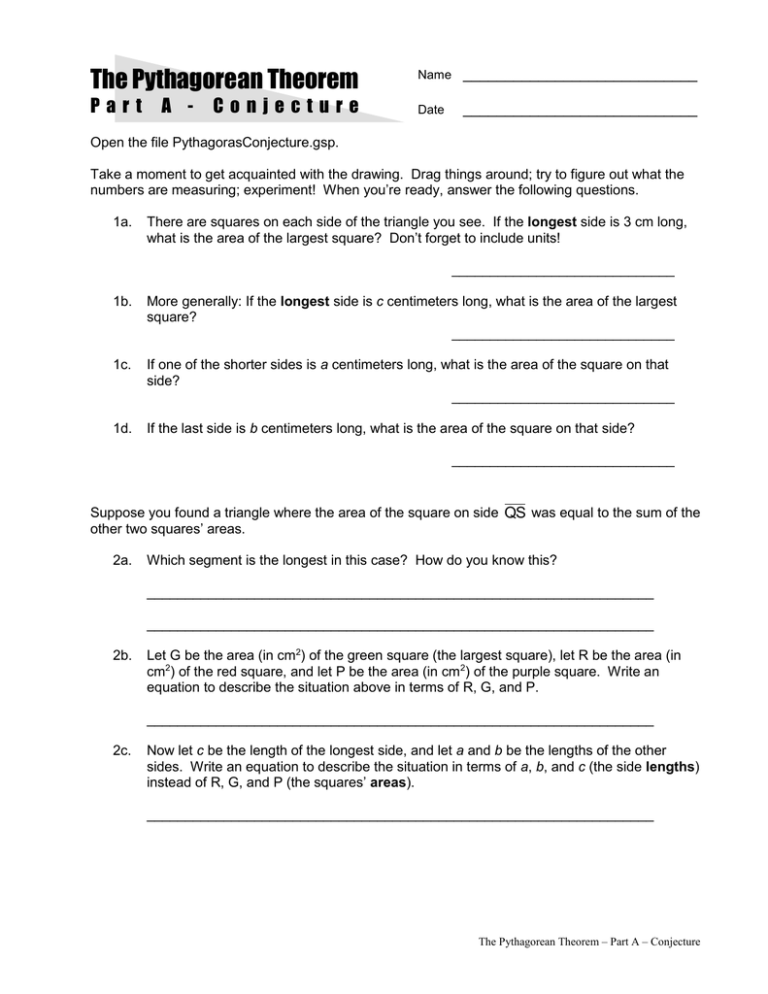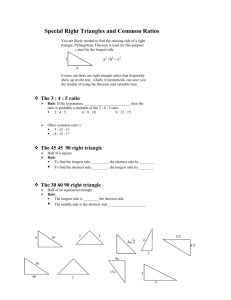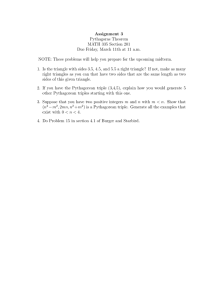The Pythagorean Theorem ____________________________
advertisement

The Pythagorean Theorem Name ____________________________ Part Date ____________________________ A - Conjecture Open the file PythagorasConjecture.gsp. Take a moment to get acquainted with the drawing. Drag things around; try to figure out what the numbers are measuring; experiment! When you’re ready, answer the following questions. 1a. There are squares on each side of the triangle you see. If the longest side is 3 cm long, what is the area of the largest square? Don’t forget to include units! _____________________________ 1b. More generally: If the longest side is c centimeters long, what is the area of the largest square? _____________________________ 1c. If one of the shorter sides is a centimeters long, what is the area of the square on that side? _____________________________ 1d. If the last side is b centimeters long, what is the area of the square on that side? _____________________________ Suppose you found a triangle where the area of the square on side QS was equal to the sum of the other two squares’ areas. 2a. Which segment is the longest in this case? How do you know this? __________________________________________________________________ __________________________________________________________________ 2b. Let G be the area (in cm2) of the green square (the largest square), let R be the area (in cm2) of the red square, and let P be the area (in cm2) of the purple square. Write an equation to describe the situation above in terms of R, G, and P. __________________________________________________________________ 2c. Now let c be the length of the longest side, and let a and b be the lengths of the other sides. Write an equation to describe the situation in terms of a, b, and c (the side lengths) instead of R, G, and P (the squares’ areas). __________________________________________________________________ The Pythagorean Theorem – Part A – Conjecture Move the triangle’s vertices until the value a2 + b2 is really close to c2 (“really close” means within 1 cm2). In the table to the right, record the angle measures gb, rg, and br, and record which side is the longest. Repeat three more times. a2 + b2 ≈ c2 longest side q r s Do the same thing again, but this time make the value a2 + b2 less than c2. a2 + b2 < c2 longest side q r s Finally, collect data when you make the value a2 + b2 greater than c2. a2 + b2 > c2 longest side q r s 3a. What seems to be true about the triangle if the sum of the two smaller squares’ areas is equal to the largest square’s area? (Think about the three types of triangles.) __________________________________________________________________ 3b. What seems to be true about the triangle if the sum of the two smaller squares’ areas is less than the largest square’s area? __________________________________________________________________ 3c. What seems to be true about the triangle if the sum of the two smaller squares’ areas is more than the largest square’s area? __________________________________________________________________ 4a. Move the vertices of the triangle until it is a right triangle. What do you notice? Is this what you expected? __________________________________________________ _____________________________________________________________________ 4b. Let c be the length of a triangle’s longest side, and let a and b be the lengths of the other two sides. Write down a conjecture (in the form of an if-then statement) about the relationship among the three squares’ areas if one of the angles is right. This is the Pythagorean Theorem. _____________________________________________________________________ _____________________________________________________________________ The Pythagorean Theorem – Part A – Conjecture



